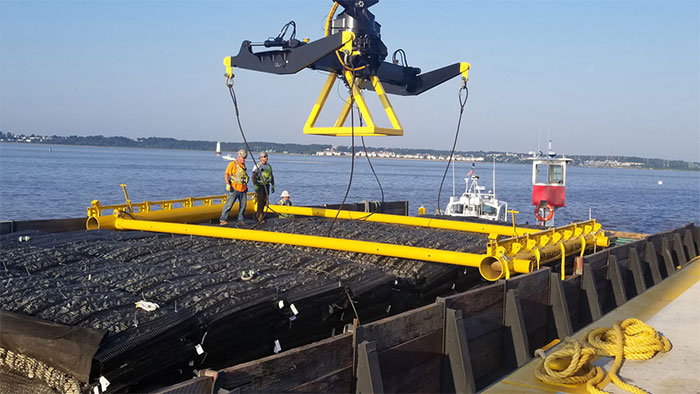The New York City government is constructing an oyster reef consisting of billions of live oysters along the southern coast as a response to climate change.
A decade after Hurricane Sandy made landfall and caused significant damage, New York City has found an innovative solution to combat the effects of climate change: building a living breakwater made of live oysters instead of concrete.

The Living Breakwaters project started in 2021 – (Photo: RAMBOLL)
This project is called Living Breakwaters and is located on Staten Island, one of the boroughs of New York City. Oyster shells from restaurants throughout New York will be collected, transported to the coast, and placed into structures designed to mimic coral reefs, made from marine stone and bio-concrete.
This structure will provide a habitat for new oysters as well as other marine organisms, eventually forming a breakwater due to the billions of live oysters that will cover it.
Clusters of oysters will create oyster reefs, providing habitats for other marine creatures such as crabs, shrimp, and fish, helping New York’s coastline withstand severe weather while also protecting local marine life and the area’s ecosystem.
The Living Breakwaters project is valued at $107 million and is expected to be completed by 2024. Expert Thad Pawlowski from Columbia University describes the Living Breakwaters project as a “meaningful, super-creative, and inspiring” initiative.
Dr. Judith Weis at Rutgers University noted that the effectiveness of the project is still to be evaluated, but emphasized that the project itself is a better solution compared to traditional concrete breakwaters.
Breakwaters are commonly chosen to mitigate the impacts of climate change. However, concrete breakwaters can come with a high price for humans. Experts argue that they risk causing higher water levels at nearby beaches and damaging ecosystems.
Earlier this year, the United Nations also warned that artificial structures like these will only exacerbate the consequences of climate change in the long run.
According to CNA, projects like Living Breakwaters are part of efforts to combat climate change following Hurricane Sandy’s devastation of New York in 2012. Within just two days, Sandy flooded nearly one-fifth of the city, destroyed 300 homes, and resulted in 44 fatalities.
The storm left thousands of New Yorkers without power and unable to access food, drinking water, medical care, and other services, causing $19 billion in damages.
New York is also implementing the Billion Oyster project, aiming to harness the water filtration capabilities of oysters to restore the ecosystem.
According to the National Oceanic and Atmospheric Administration (NOAA), a single oyster can clean up to 50 gallons (227 liters) of water each day. The Billion Oyster project has been operational since 2014, utilizing the water-cleaning abilities of oysters to restore coral reefs in the waters surrounding New York City.
Members of the Billion Oyster project have collaborated with the Living Breakwaters project to create an artificial reef extending over 3 kilometers along Staten Island’s coastline. In the future, with the effectiveness of both projects, billions of oysters may attach to it, forming natural reefs on a larger scale and at a faster rate.


















































